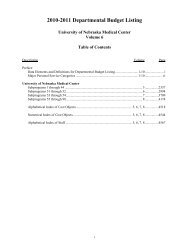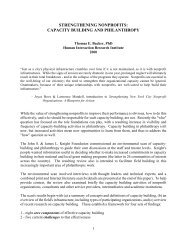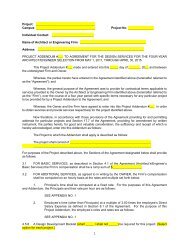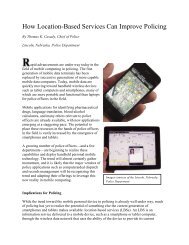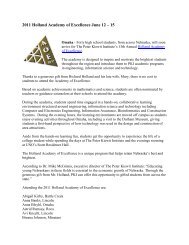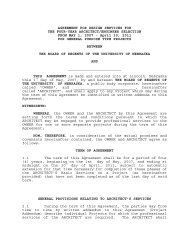Documentation of Violence Risk Information in Psychiatric Hospital ...
Documentation of Violence Risk Information in Psychiatric Hospital ...
Documentation of Violence Risk Information in Psychiatric Hospital ...
You also want an ePaper? Increase the reach of your titles
YUMPU automatically turns print PDFs into web optimized ePapers that Google loves.
<strong>Documentation</strong> <strong>of</strong> <strong>Violence</strong> <strong>Risk</strong><br />
<strong>Information</strong> <strong>in</strong> <strong>Psychiatric</strong> <strong>Hospital</strong><br />
Patient Charts: An Empirical<br />
Exam<strong>in</strong>ation<br />
Eric B. Elbogen, PhD, MLS, Alan J. Tomk<strong>in</strong>s, PhD, JD, Antara P. Pothuloori, BA,<br />
and Mario J. Scalora, PhD<br />
Studies have identified risk factors that show a strong association with violent behavior <strong>in</strong> psychiatric populations.<br />
Yet, little research has been conducted on the documentation <strong>of</strong> violence risk <strong>in</strong>formation <strong>in</strong> actual cl<strong>in</strong>ical practice,<br />
despite the relevance <strong>of</strong> such documentation to risk assessment liability and to conduct<strong>in</strong>g effective risk management.<br />
In this study, the documentation <strong>of</strong> cues <strong>of</strong> risk for violence were exam<strong>in</strong>ed <strong>in</strong> psychiatric sett<strong>in</strong>gs. Patient<br />
charts (n 283) <strong>in</strong> four psychiatric sett<strong>in</strong>gs were reviewed for documentation <strong>of</strong> violence risk <strong>in</strong>formation<br />
summarized <strong>in</strong> the MacArthur <strong>Violence</strong> <strong>Risk</strong> Assessment Study. The results revealed that particular patient and<br />
<strong>in</strong>stitutional variables <strong>in</strong>fluenced documentation practices. The presence <strong>of</strong> personality disorder, for example,<br />
predicted greater documentation <strong>of</strong> cues <strong>of</strong> violence risk, regardless <strong>of</strong> cl<strong>in</strong>ical sett<strong>in</strong>g. These f<strong>in</strong>d<strong>in</strong>gs have<br />
medicolegal implications for risk assessment liability and cl<strong>in</strong>ical implications for optimiz<strong>in</strong>g risk management <strong>in</strong><br />
psychiatric practice.<br />
J Am Acad Psychiatry Law 31:58–64, 2003<br />
Psychiatrists and other mental health pr<strong>of</strong>essionals<br />
work<strong>in</strong>g with mentally disordered patients manage<br />
and assess the risk <strong>of</strong> violence regularly, especially <strong>in</strong><br />
forensic sett<strong>in</strong>gs. 1 A vast body <strong>of</strong> cl<strong>in</strong>ical research<br />
literature seek<strong>in</strong>g to improve the accuracy <strong>of</strong> risk assessment<br />
has emerged <strong>in</strong> the past 20 years. 2,3 This<br />
research <strong>in</strong>tended to establish empirically validated<br />
violence risk factors, 4 a number <strong>of</strong> which were summarized<br />
<strong>in</strong> the MacArthur <strong>Violence</strong> <strong>Risk</strong> Assessment<br />
Study. 5 Based on these factors, researchers have<br />
sought to develop actuarial risk assessment tools for<br />
cl<strong>in</strong>ical forensic practice. 6,7 However, less attention<br />
has been devoted to how violence risk assessment and<br />
risk management are actually performed. 8,9 In par-<br />
Dr. Elbogen is a Research Fellow, Department <strong>of</strong> Psychiatry, Duke<br />
University Medical Center, Durham, NC. Dr. Tomk<strong>in</strong>s is Director <strong>of</strong><br />
the University <strong>of</strong> Nebraska Public Policy Center, L<strong>in</strong>coln, NE. Ms.<br />
Pothuloori was an undergraduate <strong>in</strong> the Department <strong>of</strong> Psychology,<br />
University <strong>of</strong> Nebraska-L<strong>in</strong>coln, L<strong>in</strong>coln, NE, at the time this manuscript<br />
was prepared. Dr. Scalora is Assistant Pr<strong>of</strong>essor <strong>of</strong> Law/Psychology<br />
<strong>in</strong> the Department <strong>of</strong> Psychology, University <strong>of</strong> Nebraska-L<strong>in</strong>coln,<br />
L<strong>in</strong>coln, NE. Dr. Elbogen was supported as a predoctoral fellow<br />
by NIMH Tra<strong>in</strong><strong>in</strong>g Grant 5T32MH16156 dur<strong>in</strong>g the preparation <strong>of</strong><br />
the manuscript. Address correspondence to: Eric B. Elbogen, PhD,<br />
MLS, Box 3071, Duke University Medical Center, Durham, NC<br />
27710. E-mail: eelbogen@psych.mc.duke.edu<br />
REGULAR ARTICLE<br />
ticular, few studies have exam<strong>in</strong>ed the daily process<br />
<strong>of</strong> documentation <strong>in</strong> violence risk assessment <strong>in</strong> psychiatric<br />
sett<strong>in</strong>gs.<br />
<strong>Documentation</strong> <strong>of</strong> key risk data is critical for liability<br />
purposes. A lawsuit may be brought months, or<br />
even years, after actual hospitalization, and given the<br />
limitations <strong>of</strong> human memory, records are necessary<br />
components <strong>in</strong> determ<strong>in</strong><strong>in</strong>g liability. 10 Thorough<br />
record-keep<strong>in</strong>g document<strong>in</strong>g that cl<strong>in</strong>icians reasonably<br />
attempted to gather the relevant <strong>in</strong>formation for<br />
risk assessment significantly limits exposure to liability.<br />
11 Beck writes that “documentation <strong>of</strong> efforts to<br />
provide an average standard <strong>of</strong> care and exercise reasonable<br />
judgment is recommended as the best means<br />
to avoid malpractice suits” (Ref. 12, p 695).<br />
Indeed, some courts have explicitly cited documentation<br />
as a key component <strong>in</strong> determ<strong>in</strong><strong>in</strong>g the<br />
pr<strong>of</strong>essional standard <strong>of</strong> care for assess<strong>in</strong>g dangerousness<br />
<strong>in</strong> psychiatric hospital sett<strong>in</strong>gs. 13 For example,<br />
<strong>in</strong> Jablonski v. U.S., 14 a Veterans Adm<strong>in</strong>istration psychiatrist<br />
was held liable for fail<strong>in</strong>g to obta<strong>in</strong> the medical<br />
and psychiatric history <strong>of</strong> a mental patient who<br />
later killed his girlfriend. The court <strong>in</strong> Littleton v.<br />
58 The Journal <strong>of</strong> the American Academy <strong>of</strong> Psychiatry and the Law
Good Samaritan <strong>Hospital</strong> and Health Center additionally<br />
stated that dangerousness assessments must<br />
be made “<strong>in</strong> light <strong>of</strong> the present day scientific knowledge<br />
<strong>in</strong> that specialty.” 15 Commentators have noted<br />
and analyzed several legal cases <strong>in</strong> which the courts<br />
discuss the relevance and importance <strong>of</strong> psychiatrists’<br />
and other mental health pr<strong>of</strong>essionals’ obta<strong>in</strong><strong>in</strong>g and<br />
document<strong>in</strong>g certa<strong>in</strong> types <strong>of</strong> risk <strong>in</strong>formation when<br />
assess<strong>in</strong>g dangerousness. 10,12<br />
In addition to liability concerns, proper documentation<br />
is also necessary for proper risk management:<br />
“The quality <strong>of</strong> any [violence risk assessment] decision<br />
can only be as good as the <strong>in</strong>formation on which<br />
it is based. ...” 6 Commentators have noted that documentation<br />
<strong>of</strong> critical risk data is key to optimiz<strong>in</strong>g<br />
prediction and management <strong>of</strong> violence <strong>in</strong> psychiatric<br />
and forensic sett<strong>in</strong>gs. 16 Recently, researchers<br />
demonstrated that a s<strong>in</strong>gle tra<strong>in</strong><strong>in</strong>g session with cl<strong>in</strong>ical<br />
staff leads to significant improvement <strong>in</strong> risk<strong>of</strong>-violence<br />
documentation with no extra time, resources,<br />
or paperwork and with true multidiscipl<strong>in</strong>ary<br />
<strong>in</strong>volvement. 17 Similarly, exam<strong>in</strong><strong>in</strong>g documentation<br />
is a necessary part <strong>of</strong> implement<strong>in</strong>g <strong>of</strong><br />
state-<strong>of</strong>-the-art violence risk assessment tools that<br />
have emerged <strong>in</strong> the past decade. Adm<strong>in</strong>istration <strong>of</strong><br />
<strong>in</strong>struments such as the Psychopathy Checklist<br />
(PCL) 18 and the <strong>Violence</strong> <strong>Risk</strong> Appraisal Guide<br />
(VRAG) 6 depend <strong>in</strong> part on access to detailed case<br />
history <strong>in</strong>formation <strong>in</strong>clud<strong>in</strong>g but not limited to<br />
crim<strong>in</strong>al history, diagnosis, history <strong>of</strong> violence, and<br />
course <strong>of</strong> hospitalization. Thus, newly developed risk<br />
assessment measures require thorough documentation<br />
<strong>of</strong> risk <strong>in</strong>formation.<br />
However, little is known about how <strong>in</strong>formation<br />
regard<strong>in</strong>g the risk <strong>of</strong> violence is documented <strong>in</strong> actual<br />
cl<strong>in</strong>ical practice. With respect to suicide risk management,<br />
Malone et al. 19 found that history <strong>of</strong> suicide<br />
was <strong>of</strong>ten not documented for suicidal patients and<br />
that patient characteristics, such as presence <strong>of</strong> personality<br />
disorder, <strong>in</strong>fluenced documentation <strong>of</strong> risk<br />
factors for suicidal behavior. Do the patient’s characteristics<br />
<strong>in</strong>fluence documentation <strong>of</strong> violence risk<br />
<strong>in</strong>formation <strong>in</strong> a correspond<strong>in</strong>g manner? If so, what<br />
patient variables seem to affect documentation practices,<br />
and <strong>in</strong> what ways? Institutional sett<strong>in</strong>g may also<br />
affect documentation for assessment <strong>of</strong> violence<br />
risk. 9 If this is the case, how might <strong>in</strong>stitutional sett<strong>in</strong>g<br />
affect documentation <strong>of</strong> violence risk <strong>in</strong>formation?<br />
Are cl<strong>in</strong>icians document<strong>in</strong>g risk data systematically<br />
across different sett<strong>in</strong>gs? The purpose <strong>of</strong> this<br />
Elbogen, Tomk<strong>in</strong>s, Pothuloori, et al.<br />
study was to resolve these questions and to <strong>in</strong>vestigate<br />
empirically the cl<strong>in</strong>ical documentation <strong>of</strong> <strong>in</strong>formation<br />
related to risk <strong>of</strong> violence <strong>in</strong> psychiatric<br />
sett<strong>in</strong>gs.<br />
Methods<br />
Volume 31, Number 1, 2003<br />
Sett<strong>in</strong>g<br />
This study was conducted <strong>in</strong> L<strong>in</strong>coln, Nebraska<br />
(population 250,000), and <strong>in</strong>volved four <strong>in</strong>patient<br />
psychiatric sett<strong>in</strong>gs: acute, chronic, crisis, and forensic.<br />
The acute, chronic, and forensic hospitals are<br />
located <strong>in</strong> a 240-bed, state-operated psychiatric facility<br />
that serves most <strong>of</strong> the severely mentally ill patients<br />
<strong>in</strong> Nebraska and surround<strong>in</strong>g states. Half <strong>of</strong><br />
the facility’s beds are housed <strong>in</strong> the forensic hospital<br />
where evaluation and treatment services are provided<br />
for adults found Not Responsible by Reason <strong>of</strong> Insanity<br />
and Incompetent to Stand Trial as well as civilly<br />
committed sex <strong>of</strong>fenders. Nonforensic adult patients<br />
who are civilly committed are first stabilized <strong>in</strong><br />
the 40-bed acute-care hospital (average length <strong>of</strong><br />
stay, 68 days). Those nonforensic adult patients who<br />
need more <strong>in</strong>tensive care are treated at the 40-bed<br />
chronic care hospital, which <strong>of</strong>fers extensive psychosocial<br />
rehabilitation for long-term patients. The<br />
county crisis center is located with<strong>in</strong> the local community<br />
mental health center and is a 15-bed facility<br />
that serves as the <strong>in</strong>itial gateway for longer-term <strong>in</strong>patient<br />
mental health services. Patients at risk to<br />
harm themselves or others are brought to the crisis<br />
center for evaluation <strong>of</strong> the appropriateness <strong>of</strong> civil<br />
commitment. The crisis center receives more than 50<br />
admissions per month, with an average length <strong>of</strong> stay<br />
<strong>of</strong> 12 days. Patients are discharged to the community<br />
or transferred to other <strong>in</strong>patient facilities, typically<br />
the state hospital.<br />
For statistical analysis, each facility was categorized<br />
by location, type <strong>of</strong> population, and patient<br />
legal status at admission. With respect to location,<br />
each facility was labeled as either a crisis or state<br />
hospital facility. Type <strong>of</strong> population was characterized<br />
as either acute (def<strong>in</strong>ed as average length <strong>of</strong> stay<br />
less than three months) or chronic (more than three<br />
months’ average length <strong>of</strong> stay). By such def<strong>in</strong>itions,<br />
the crisis center and acute unit were def<strong>in</strong>ed as acute<br />
whereas the chronic and forensic units were considered<br />
chronic. F<strong>in</strong>ally, legal status designat<strong>in</strong>g type <strong>of</strong><br />
commitment was divided <strong>in</strong>to civil and crim<strong>in</strong>al. All<br />
59
facilities except for the forensic units were classified<br />
<strong>in</strong> the civil category.<br />
Procedure<br />
Approval to conduct this research was obta<strong>in</strong>ed<br />
from the University <strong>of</strong> Nebraska-L<strong>in</strong>coln Institutional<br />
Review Board. Privacy concerns were <strong>in</strong>cluded<br />
<strong>in</strong> the protocol for review <strong>of</strong> the archival data. Research<br />
assistants retrospectively rated documented<br />
<strong>in</strong>formation rout<strong>in</strong>ely collected on patient charts<br />
dur<strong>in</strong>g the provision <strong>of</strong> cl<strong>in</strong>ical care. Although there<br />
was no assurance that all the <strong>in</strong>formation available<br />
for a given patient would be <strong>in</strong>cluded on the patient’s<br />
chart, it was assumed that most <strong>of</strong> the <strong>in</strong>formation<br />
available would be reflected <strong>in</strong> the ma<strong>in</strong> reports. A<br />
cue <strong>of</strong> risk for violence was rated as documented if<br />
any mention <strong>of</strong> the cue was made <strong>in</strong> the ma<strong>in</strong> reports<br />
<strong>in</strong> the patient’s chart. Research assistants exam<strong>in</strong>ed<br />
cl<strong>in</strong>ical staff reports <strong>in</strong> patients’ medical records,<br />
which are those records on charts that are typically<br />
available to staff while the patient is be<strong>in</strong>g treated <strong>in</strong><br />
the facility. Staff reports <strong>in</strong>cluded psychiatrists’ admission<br />
and discharge summaries, discharge <strong>in</strong>formation<br />
sheets, social work reports, nurs<strong>in</strong>g assessments,<br />
and psychology reports.<br />
Independent variables <strong>in</strong> this study <strong>in</strong>cluded 14<br />
variables that were always documented, <strong>in</strong>clud<strong>in</strong>g<br />
demographics (age, gender, marital status, ethnicity),<br />
symptoms at <strong>in</strong>itial exam<strong>in</strong>ation (suicidal, homicidal,<br />
both suicidal and homicidal, psychosis), and<br />
cl<strong>in</strong>ical variables (substance abuse, psychotic disorder,<br />
personality disorder), as well as variables based<br />
on contextual dimensions described earlier (chronic<br />
versus acute, crim<strong>in</strong>al versus civil, and crisis versus<br />
state hospital).<br />
Dependent variables collected <strong>in</strong> this study were<br />
those identified by the MacArthur <strong>Violence</strong> <strong>Risk</strong> Assessment<br />
Study as possible risk factors associated<br />
with violence. 5 This <strong>in</strong>cluded several risk doma<strong>in</strong>s,<br />
<strong>in</strong>clud<strong>in</strong>g social history (family history, family deviance,<br />
work history, educational history, prior hospitalizations,<br />
history <strong>of</strong> treatment compliance),<br />
violence history (history <strong>of</strong> arrests, history <strong>of</strong> <strong>in</strong>carcerations,<br />
self-reported violence, violence toward<br />
self), contextual (perceived stress, liv<strong>in</strong>g arrangements,<br />
activities <strong>of</strong> daily liv<strong>in</strong>g, perceived support,<br />
social networks, means for violence, e.g., access to<br />
weapons), cl<strong>in</strong>ical (Axis I diagnosis, delusions, halluc<strong>in</strong>ations,<br />
symptom severity, violent fantasies, Axis II<br />
diagnosis, substance abuse), and dispositional de-<br />
<strong>Documentation</strong> <strong>of</strong> <strong>Violence</strong> <strong>Risk</strong> <strong>Information</strong><br />
scription and test results (personality style, anger,<br />
impulsiveness, psychopathy, IQ, and neurological<br />
impairment).<br />
Patients’ charts (n 283) were reviewed for documentation<br />
<strong>of</strong> cues <strong>of</strong> risk for violence <strong>in</strong> four psychiatric<br />
sett<strong>in</strong>gs. One hundred thirty charts were randomly<br />
selected from a list <strong>of</strong> patients discharged<br />
between January 1994 and January 1998 from the<br />
acute (n 65), chronic (n 32), and forensic (n <br />
33) hospitals. Patients’ chart rat<strong>in</strong>gs at the state hospital<br />
facility were made by four research assistants<br />
who achieved an <strong>in</strong>ter-rater reliability <strong>of</strong> .77<br />
before start<strong>in</strong>g the chart reviews, <strong>in</strong>dicat<strong>in</strong>g a good<br />
level <strong>of</strong> <strong>in</strong>ter-rater reliability. At the county crisis center,<br />
153 charts were randomly selected from a list <strong>of</strong><br />
patients discharged from the crisis center between<br />
January 1994 and January 1998. Patient charts at the<br />
crisis center were rated by four research assistants<br />
who achieved an <strong>in</strong>ter-rater reliability <strong>of</strong> .87<br />
before the chart reviews were begun, <strong>in</strong>dicat<strong>in</strong>g a very<br />
good level <strong>of</strong> <strong>in</strong>ter-rater reliability.<br />
Results<br />
Descriptive analyses were used to exam<strong>in</strong>e demographic<br />
and cl<strong>in</strong>ical characteristics <strong>of</strong> the patients<br />
whose charts were exam<strong>in</strong>ed. Of those charts randomly<br />
selected, the sample was 66.1 percent male<br />
and had a mean age <strong>of</strong> 35.7 years. Ethnic breakdown<br />
was 85 percent white, 8.5 percent African-American,<br />
1.8 percent Hispanic, 2.9 percent Asian, and 1.5 percent<br />
Native American, generally representative <strong>of</strong> the<br />
general population <strong>in</strong> the jurisdiction. Regard<strong>in</strong>g<br />
marital status, nearly half the sample (47.3%) had<br />
never been married, 15.3 percent were married, 8<br />
percent were separated, and 27.4 percent were divorced.<br />
With respect to cl<strong>in</strong>ical characteristics, 35.3<br />
percent had a diagnosis <strong>of</strong> psychosis (compared with<br />
64.7% with mood disorders), 53.7 percent had a<br />
diagnosis <strong>of</strong> substance abuse, and 48.4 percent had a<br />
diagnosis <strong>of</strong> some type <strong>of</strong> Axis II personality disorder.<br />
F<strong>in</strong>ally, we exam<strong>in</strong>ed problems present at admission:<br />
violence (29.0% <strong>of</strong> the sample), psychosis (27.6%),<br />
suicidality (60.4%), and violence plus suicidality<br />
(17.0%).<br />
Regression analyses were used to determ<strong>in</strong>e<br />
whether demographic variables, problems at admission,<br />
cl<strong>in</strong>ical assessment, or cl<strong>in</strong>ical sett<strong>in</strong>g predicted<br />
total documentation <strong>of</strong> <strong>in</strong>formation regard<strong>in</strong>g risk <strong>of</strong><br />
violence (Table 1). Results <strong>of</strong> the analysis showed<br />
that the 14 selected variables accounted for 45 per-<br />
60 The Journal <strong>of</strong> the American Academy <strong>of</strong> Psychiatry and the Law
Table 1 Regression Analysis <strong>of</strong> Total <strong>Documentation</strong> <strong>of</strong> <strong>Violence</strong><br />
<strong>Risk</strong> Cues<br />
Predictor p<br />
Demographics<br />
Age <strong>in</strong> years .050 .312<br />
Gender (M/F) .054 .283<br />
Married? (no/yes) .039 .439<br />
Caucasian? (no/yes)<br />
Present<strong>in</strong>g problem<br />
.020 .683<br />
Psychotic at admission? (no/yes) .024 .713<br />
Suicidal at admission? (no/yes) .107 .093<br />
Violent and Suicidal? (no/yes) .048 .762<br />
<strong>Violence</strong> at admission? (no/yes)<br />
Cl<strong>in</strong>ical diagnosis<br />
.024 .878<br />
Substance abuse diagnosis? (no/yes) .029 .563<br />
Psychotic diagnosis? (no/yes) .048 .483<br />
Personality disorder? (no/yes)<br />
Cl<strong>in</strong>ical sett<strong>in</strong>g<br />
.194 .001*<br />
Population (chronic/acute) .022 .785<br />
Legal status (crim<strong>in</strong>al/civil) .012 .870<br />
Location (crisis/state hospital)<br />
* p .001.<br />
.639 .001*<br />
cent <strong>of</strong> the variance <strong>in</strong> total documentation (R 2 <br />
.453, p .000). In terms <strong>of</strong> those specific variables<br />
that significantly predicted documentation, the analysis<br />
showed that state hospital charts conta<strong>in</strong>ed much<br />
greater documentation <strong>of</strong> violence risk factors than<br />
crisis center charts ( .639, p .001). However,<br />
the analysis also showed that, when account<strong>in</strong>g for<br />
sett<strong>in</strong>g variables, the presence <strong>of</strong> a personality disorder<br />
predicted significantly <strong>in</strong>creased documentation<br />
Table 2 Relationship <strong>of</strong> Patient and Sett<strong>in</strong>g Variables to Cue Doma<strong>in</strong> <strong>Documentation</strong><br />
( .194, p .001), suggest<strong>in</strong>g that this f<strong>in</strong>d<strong>in</strong>g is<br />
general across all four hospital facilities studied. Be<strong>in</strong>g<br />
suicidal at admission also tended to lead to record<strong>in</strong>g<br />
<strong>of</strong> more violence risk factors; however, this<br />
trend was not statistically significant ( .107, p <br />
.093). Neither a patient’s be<strong>in</strong>g only violent nor be<strong>in</strong>g<br />
violent and suicidal at admission was related to<br />
total documentation <strong>of</strong> violence risk factors.<br />
Regression analyses were used to determ<strong>in</strong>e the<br />
effect <strong>of</strong> the 14 variables on documentation <strong>in</strong> five<br />
cue doma<strong>in</strong>s <strong>of</strong> the MacArthur <strong>Risk</strong> Assessment<br />
Study: cl<strong>in</strong>ical, contextual, violence, social, and test<strong>in</strong>g<br />
(Table 2). In the cl<strong>in</strong>ical doma<strong>in</strong>, only the presence<br />
<strong>of</strong> a personality disorder <strong>in</strong>creased documentation<br />
( .263, p .001). <strong>Documentation</strong> <strong>of</strong><br />
contextual <strong>in</strong>formation was positively <strong>in</strong>fluenced by<br />
suicidality identified at admission ( .189, p <br />
.013) and by the chart’s be<strong>in</strong>g from the state hospital<br />
( .503, p .001).<br />
The 14 variables accounted for 58 percent <strong>of</strong> the<br />
variance <strong>in</strong> documentation <strong>of</strong> violence history factors<br />
(R 2 .576, p .001). Although charts <strong>of</strong> males<br />
conta<strong>in</strong>ed more history <strong>of</strong> violence ( .198, p <br />
.001), documentation <strong>of</strong> violence history was ma<strong>in</strong>ly<br />
<strong>in</strong>fluenced by cl<strong>in</strong>ical sett<strong>in</strong>g. Chronic unit charts<br />
showed more documentation <strong>of</strong> violence history<br />
( .159, p .023) than acute units, and the<br />
forensic unit showed more documentation <strong>in</strong> this<br />
Cl<strong>in</strong>ical Contextual <strong>Violence</strong> History Social History Test<strong>in</strong>g<br />
Predictor<br />
Demographics<br />
p p p p p<br />
Age <strong>in</strong> years .10 .883 .042 .484 .037 .396 .073 .222 .018 .765<br />
Gender (M/F) .028 .667 .028 .641 .198 .001* .017 .777 .044 .466<br />
Married .008 .906 .015 .808 .035 .433 .043 .473 .018 .765<br />
White<br />
Present<strong>in</strong>g problem<br />
.002 .977 .003 .955 .018 .669 .077 .183 .004 .939<br />
Psychotic .044 .595 .006 .939 .014 .806 .048 .528 .138 .076<br />
Suicidal only .109 .184 .189 .013† .031 .574 .046 .546 .030 .695<br />
<strong>Violence</strong> only .116 .571 .052 .783 .115 .413 .206 .277 .111 .564<br />
Violent and suicidal<br />
Cl<strong>in</strong>ical diagnosis<br />
.125 .540 .022 .906 .070 .614 .208 .268 .201 .290<br />
Substance abuse .047 .469 .004 .947 .001 .981 .015 .807 .058 .342<br />
Thought disorder .024 .784 .076 .349 .081 .176 .047 .559 .072 .382<br />
Personality disorder<br />
Cl<strong>in</strong>ical sett<strong>in</strong>g<br />
.263 .001* .062 .333 .086 .068 .067 .296 .147 .023†<br />
Chronic/acute .002 .983 .010 .916 .159 .023† .029 .759 .263 .006†<br />
Crim<strong>in</strong>al/civil .074 .429 .103 .238 .266 .001* .175 .044† .205 .020†<br />
Crisis/state hospital .045 .603 .503 .001* .654 .001* .478 .001* .321 .001*<br />
* p .001. † p .05.<br />
Elbogen, Tomk<strong>in</strong>s, Pothuloori, et al.<br />
Volume 31, Number 1, 2003<br />
61
area ( .266, p .000) than did other units. If<br />
the chart was a crisis chart, documentation <strong>of</strong> violence<br />
was significantly less ( .654, p .001). The<br />
presence <strong>of</strong> a personality disorder tended to <strong>in</strong>crease<br />
documentation <strong>of</strong> violence history, but not significantly<br />
( .086, p .068). Regard<strong>in</strong>g social history<br />
<strong>in</strong>formation, charts from the crim<strong>in</strong>al facility<br />
conta<strong>in</strong>ed significantly less documentation ( <br />
.175, p .044) than did civil facility charts. There<br />
was also less documentation if the patient was a crisis<br />
patient ( .478, p .001).<br />
Correspond<strong>in</strong>gly, charts <strong>in</strong> chronic ( .263,<br />
p .006) and civil ( .205, p .020) sett<strong>in</strong>gs<br />
showed greater documentation <strong>of</strong> test<strong>in</strong>g <strong>in</strong>formation.<br />
Further, crisis charts conta<strong>in</strong>ed significantly less<br />
test<strong>in</strong>g history documentation ( .321, p .001),<br />
but <strong>in</strong>formation <strong>in</strong>creased when the patient had a<br />
personality disorder ( .147, p .023). In addition,<br />
if a patient had psychosis at admission, there<br />
was a trend toward less documentation <strong>of</strong> test<strong>in</strong>g<br />
( .138, p .076) that approached, but did not<br />
achieve, statistical significance.<br />
Discussion<br />
Overall, the results suggest that <strong>in</strong>stitutional and<br />
<strong>in</strong>trapatient variables affect documentation <strong>of</strong> violence<br />
risk <strong>in</strong>formation. With respect to <strong>in</strong>stitutional<br />
variables, the current study <strong>in</strong>dicates that social and<br />
violence history data are less likely to be documented<br />
<strong>in</strong> crisis centers than <strong>in</strong> other longer-term psychiatric<br />
sett<strong>in</strong>gs. Because patients <strong>in</strong> crisis centers are <strong>of</strong>ten<br />
admitted because <strong>of</strong> the harm they pose to themselves<br />
or others, an <strong>in</strong>take violence risk assessment<br />
may be hurried, or <strong>in</strong>formation may simply not yet<br />
be available. Patients may also be evaluated dur<strong>in</strong>g<br />
acute psychosis and thereby be unreliable historians.<br />
Gardner and colleagues 20 additionally note “a patient<br />
fear<strong>in</strong>g commitment may be reluctant to volunteer<br />
reports <strong>of</strong> violence” (Ref. 20, p 602). F<strong>in</strong>ally,<br />
patients may have no family members to contact and<br />
corroborate self-reported violence histories. Although<br />
risk assessment is vital to the discharge disposition<br />
<strong>of</strong> patients <strong>in</strong> the crisis center, the f<strong>in</strong>d<strong>in</strong>gs<br />
suggest that cl<strong>in</strong>icians <strong>in</strong> these sett<strong>in</strong>gs may lack important<br />
risk <strong>in</strong>formation, especially compared with<br />
their counterparts <strong>in</strong> other contexts.<br />
This suggests that the standard <strong>of</strong> care for assessment<br />
<strong>of</strong> dangerousness should vary as a function <strong>of</strong><br />
the sett<strong>in</strong>g under which the evaluation occurs, an<br />
implication heret<strong>of</strong>ore not considered explicitly by<br />
<strong>Documentation</strong> <strong>of</strong> <strong>Violence</strong> <strong>Risk</strong> <strong>Information</strong><br />
the courts <strong>in</strong> the United States. In the realm <strong>of</strong> tort<br />
liability, cl<strong>in</strong>icians have been held liable for mak<strong>in</strong>g<br />
an <strong>in</strong>sufficient effort to gather and document <strong>in</strong>formation<br />
that would make an accurate prediction possible.<br />
10,13,14,21 Generally courts f<strong>in</strong>d negligence<br />
when cl<strong>in</strong>icians fail to document what can be acquired<br />
with<strong>in</strong> reason. 12 However, the present f<strong>in</strong>d<strong>in</strong>gs<br />
suggest that risk <strong>in</strong>formation is differentially<br />
available <strong>in</strong> different sett<strong>in</strong>gs: critical risk data that<br />
may be reasonable for a cl<strong>in</strong>ician work<strong>in</strong>g <strong>in</strong> a longerterm<br />
sett<strong>in</strong>g to obta<strong>in</strong> may be unreasonable for a<br />
crisis cl<strong>in</strong>ician to obta<strong>in</strong>. Thus, the results <strong>in</strong>dicate<br />
that because dangerousness assessments are dependent<br />
on the conditions under which they take place, 9<br />
liability standards for psychiatrists and other mental<br />
health pr<strong>of</strong>essionals arguably ought to be formulated<br />
accord<strong>in</strong>gly.<br />
The f<strong>in</strong>d<strong>in</strong>gs regard<strong>in</strong>g <strong>in</strong>stitutional variables have<br />
implications for implementation <strong>of</strong> new risk-assessment<br />
technology. Without appropriate and thorough<br />
documentation <strong>of</strong> such factors for each patient,<br />
complete utility cannot be realized and newly developed<br />
risk-assessment devices will be <strong>in</strong>adequate. Certa<strong>in</strong><br />
cl<strong>in</strong>icians may be hesitant to use new risk-assessment<br />
tools because <strong>of</strong> limitations <strong>of</strong> <strong>in</strong>formation. For<br />
example, there was more documentation <strong>of</strong> violence<br />
risk <strong>in</strong>formation <strong>in</strong> total <strong>in</strong> crim<strong>in</strong>al compared with<br />
civil facilities, probably because the former also<br />
tended to have greater communication with the<br />
crim<strong>in</strong>al justice system than the latter. 22 For these<br />
reasons, researchers may need to match risk measures<br />
with the demands <strong>of</strong> specific cl<strong>in</strong>ical contexts. Otherwise,<br />
these measures may not have cl<strong>in</strong>ical utility <strong>in</strong><br />
contexts <strong>in</strong> which documentation <strong>of</strong> key risk <strong>in</strong>formation<br />
is less likely to be available. 20<br />
The results also <strong>in</strong>dicate that <strong>in</strong>terpatient variables<br />
<strong>in</strong>fluenced the documentation process. The presence<br />
<strong>of</strong> a personality disorder appeared to <strong>in</strong>crease total<br />
documentation <strong>of</strong> violence risk <strong>in</strong>formation and specifically<br />
documentation <strong>of</strong> cl<strong>in</strong>ical and dispositional<br />
and test<strong>in</strong>g <strong>in</strong>formation. This result is similar to f<strong>in</strong>d<strong>in</strong>gs<br />
<strong>in</strong> other research show<strong>in</strong>g an effect <strong>of</strong> personality<br />
disorder on documentation <strong>of</strong> suicide history. As discussed<br />
by Malone and colleagues, 19 this suggests that<br />
documentation practice is not consistent from patient<br />
to patient. Further, charts <strong>of</strong> male patients<br />
showed greater documentation <strong>of</strong> violence history<br />
risk factors. Because sett<strong>in</strong>g was controlled for <strong>in</strong> the<br />
regression analysis, these f<strong>in</strong>d<strong>in</strong>gs could be generalized<br />
across the cl<strong>in</strong>ical sett<strong>in</strong>gs <strong>in</strong> the current study.<br />
62 The Journal <strong>of</strong> the American Academy <strong>of</strong> Psychiatry and the Law
Research exists that identifies a relationship between<br />
personality disorders and violence. 23 However,<br />
does this imply that cl<strong>in</strong>icians should differentially<br />
document risk <strong>in</strong>formation for patients with<br />
and without personality disorders? Certa<strong>in</strong>ly, cl<strong>in</strong>icians<br />
may have more cl<strong>in</strong>ical concern for patients<br />
with Axis II disorders and <strong>in</strong>deed, there is literature<br />
suggest<strong>in</strong>g that these patients occupy a disproportionate<br />
amount <strong>of</strong> cl<strong>in</strong>ician time and energy. 24 Further,<br />
psychopathy, which is conceptually similar to<br />
antisocial personality disorder, has shown strong associations<br />
with violence <strong>in</strong> different populations. 6,18<br />
However, nonconfirm<strong>in</strong>g data are just as critical for<br />
improv<strong>in</strong>g the accuracy <strong>of</strong> cl<strong>in</strong>ical decision-mak<strong>in</strong>g<br />
<strong>in</strong> general. 25 In addition, although males are <strong>in</strong> general<br />
more violent than females, it is unclear that this<br />
gender gap <strong>in</strong> violence exists <strong>in</strong> psychiatric populations.<br />
26 Indeed, a number <strong>of</strong> studies have shown<br />
equal levels <strong>of</strong> violence and <strong>in</strong> some cases greater<br />
violence <strong>in</strong> females than <strong>in</strong> males when measured <strong>in</strong><br />
psychiatric populations. 27 With respect to the f<strong>in</strong>d<strong>in</strong>gs<br />
<strong>in</strong> the present study, future analysis is necessary<br />
to determ<strong>in</strong>e whether it is good policy and procedure<br />
to document <strong>in</strong> ways that may be considered<br />
unsystematic.<br />
A limitation <strong>of</strong> this study concerns its use <strong>of</strong> one<br />
site for each psychiatric sett<strong>in</strong>g. It is possible that<br />
f<strong>in</strong>d<strong>in</strong>gs rely on procedures specific to the particular<br />
crisis center and state hospital sett<strong>in</strong>gs <strong>in</strong>vestigated <strong>in</strong><br />
this study. Thus, the generalizability may be limited,<br />
and further research is necessary to determ<strong>in</strong>e<br />
whether the same pattern <strong>of</strong> documentation emerges<br />
<strong>in</strong> different geographic locations. It is also important<br />
to note that the MacArthur Study eventually used a<br />
subset <strong>of</strong> the risk cues studied here<strong>in</strong> to construct an<br />
actuarial model. 28 As the data <strong>in</strong> this study were collected<br />
and analyzed before construction <strong>of</strong> this<br />
model, it was not possible to exam<strong>in</strong>e the effect <strong>of</strong><br />
context and characteristics <strong>of</strong> patients on documentation<br />
<strong>of</strong> violence risk factors used <strong>in</strong> the f<strong>in</strong>al actuarial<br />
model proposed by the MacArthur study. Thus,<br />
future research should <strong>in</strong>vestigate whether the k<strong>in</strong>ds<br />
<strong>of</strong> variables researchers use <strong>in</strong> actuarial formulas are<br />
typically documented <strong>in</strong> psychiatric hospital charts.<br />
In sum, to obta<strong>in</strong> a clearer and more comprehensive<br />
understand<strong>in</strong>g <strong>of</strong> documentation <strong>of</strong> risk <strong>in</strong>formation,<br />
future research should be conducted at different<br />
research sites, us<strong>in</strong>g additional and more direct<br />
methodology, and exam<strong>in</strong><strong>in</strong>g specifically the docu-<br />
Elbogen, Tomk<strong>in</strong>s, Pothuloori, et al.<br />
Volume 31, Number 1, 2003<br />
mentation needed for risk <strong>in</strong>formation used <strong>in</strong> actuarial<br />
measures.<br />
Future research should consider ga<strong>in</strong><strong>in</strong>g a clearer<br />
understand<strong>in</strong>g <strong>of</strong> how documentation affects cl<strong>in</strong>ical<br />
decision mak<strong>in</strong>g. Investigations <strong>of</strong> corrective measures<br />
through the use <strong>of</strong> structured procedures could<br />
improve documentation and ensure that sufficient<br />
<strong>in</strong>formation is available to meet the required standards<br />
<strong>of</strong> care. In addition, future research could identify<br />
how logistical hurdles relate to documentation<br />
and determ<strong>in</strong>e ways to overcome limitations. For example,<br />
given the current environment <strong>of</strong> managed<br />
care, how realistic is it to obta<strong>in</strong> all risk factors needed<br />
for actuarial formulas? 30 Thus, greater attention<br />
should be given to how cl<strong>in</strong>icians prioritize obta<strong>in</strong><strong>in</strong>g<br />
necessary <strong>in</strong>formation to make real-world cl<strong>in</strong>ical decisions,<br />
as opposed to obta<strong>in</strong><strong>in</strong>g all empirically validated<br />
<strong>in</strong>formation necessary to use actuarial tools.<br />
Some commentators have noted that cl<strong>in</strong>icians rely<br />
on dynamic risk factor variables, even though much<br />
<strong>of</strong> the research has been focused on static variables. 31<br />
Further, given limited time to make cl<strong>in</strong>ical decisions<br />
<strong>in</strong> many contexts, it may not be feasible to complete<br />
a thorough search for the factors necessary for some<br />
actuarial measures. In the end, more research is<br />
needed to understand how documentation occurs <strong>in</strong><br />
psychiatric practice and the cl<strong>in</strong>ical and forensic<br />
problems <strong>in</strong>volved <strong>in</strong> the documentation <strong>of</strong> cues for<br />
risk <strong>of</strong> violence <strong>in</strong> psychiatric hospitals.<br />
Acknowledgments<br />
The authors thank members <strong>of</strong> the Harvard Medical School<br />
Law and Psychiatry Program at the Massachusetts Mental Health<br />
Center for comments on an early draft <strong>of</strong> the manuscript.<br />
References<br />
1. Gutheil TG, Appelbaum PS: Cl<strong>in</strong>ical Handbook <strong>of</strong> Psychiatry<br />
and the Law (ed 3). New York: Lipp<strong>in</strong>cott Williams & Wilk<strong>in</strong>s,<br />
2000<br />
2. Monahan J: The Cl<strong>in</strong>ical Prediction <strong>of</strong> Violent Behavior. Rockville,<br />
MD: National Institute <strong>of</strong> Mental Health, 1981<br />
3. Lidz C, Mulvey E, Gardner W: The accuracy <strong>of</strong> predictions <strong>of</strong><br />
violence to others. JAMA 269:1007–11, 1993<br />
4. McNeil DE: Empirically based cl<strong>in</strong>ical evaluation and management<br />
<strong>of</strong> the potentially violent patient, <strong>in</strong> Emergencies <strong>in</strong> Mental<br />
Health Practice: Evaluation and Management. Edited by<br />
Kleespies PM. New York: Guilford Press, 1998, pp 95–116<br />
5. Monahan J, Steadman H: <strong>Violence</strong> and Mental Disorder: Developments<br />
<strong>in</strong> <strong>Risk</strong> Assessment. Chicago: University <strong>of</strong> Chicago<br />
Press, 1994<br />
6. Qu<strong>in</strong>sey VL, Harris GT, Rice ME, et al: Violent Offenders: Apprais<strong>in</strong>g<br />
and Manag<strong>in</strong>g <strong>Risk</strong>. Wash<strong>in</strong>gton, DC: American Psychological<br />
Association, 1998, pp 178–9<br />
7. Monahan J, Steadman HJ, Appelbaum PS, et al: Develop<strong>in</strong>g a<br />
63
cl<strong>in</strong>ically useful actuarial tool for assess<strong>in</strong>g violence risk. Br J Psychiatry<br />
176:299–312, 2001<br />
8. Grisso T: Cl<strong>in</strong>ical assessments for legal decisionmak<strong>in</strong>g <strong>in</strong> crim<strong>in</strong>al<br />
cases: research recommendations, <strong>in</strong> Mental Health and Law:<br />
Research, Policy, and Services. Edited by Sales BD, Shah S.<br />
Durham, NC: Carol<strong>in</strong>a Academic Press, 1996, pp 109–40<br />
9. Mulvey E, Lidz C: Conditional prediction: a model for research<br />
on dangerousness to others <strong>in</strong> a new era. Int J Law Psychiatry<br />
18:129–43, 1995<br />
10. Monahan J: Limit<strong>in</strong>g therapist exposure to Taras<strong>of</strong>f liability. Am<br />
Psychol 48:242–9, 1993<br />
11. Borum R, Otto R, Gold<strong>in</strong>g S: Improv<strong>in</strong>g cl<strong>in</strong>ical judgment and<br />
decision mak<strong>in</strong>g <strong>in</strong> forensic evaluation. J Am Acad Psychiatry Law<br />
21:35–76, 1993<br />
12. Beck JC: The potentially violent patient: legal duties, cl<strong>in</strong>ical practice,<br />
and risk management. Psychiatr Ann 17:695–9, 1987<br />
13. Underwood v. U.S., 356 F.2d 92 (5th Cir. 1966)<br />
14. Jablonski v. U.S., 712 F.2d 391 (9th Cir. 1982)<br />
15. Littleton v. Good Samaritan <strong>Hospital</strong> and Health Center, 529<br />
N.E.2d 449, 455 (Ohio 1988)<br />
16. Shapiro DL: Pr<strong>of</strong>essional and legal responsibilities <strong>of</strong> the therapist<br />
confronted with potential violent behavior <strong>in</strong> a patient, <strong>in</strong> Violent<br />
Behavior: Assessment and Intervention (vol 1). Edited by<br />
Hertzberg LJ, Ostrum GF. Costa Mesa, CA: PMA Publish<strong>in</strong>g<br />
Corp., 1990, pp 281–96<br />
17. Campbell M, Chapl<strong>in</strong> R: Improv<strong>in</strong>g the assessment <strong>of</strong> risk <strong>of</strong><br />
violence: a cl<strong>in</strong>ical audit <strong>of</strong> case note documentation. Psychiatr<br />
Bull 25:250–2, 2001<br />
18. Hare RD: The Hare Psychopathy Checklist-Revised (PCL-R).<br />
Toronto: Multi-Health Systems, 1991<br />
19. Malone KM, Szanto K, Corbitt EM, et al: Cl<strong>in</strong>ical assessment<br />
versus research methods <strong>in</strong> the assessment <strong>of</strong> suicidal behavior.<br />
Am J Psychiatry 152:1601–7, 1995<br />
20. Gardner W, Lidz CW, Mulvey EP, et al: Cl<strong>in</strong>ical versus actuarial<br />
predictions <strong>of</strong> violence <strong>in</strong> patients with mental illnesses. J Consult<br />
Cl<strong>in</strong> Psychol 64:602–9, 1996<br />
<strong>Documentation</strong> <strong>of</strong> <strong>Violence</strong> <strong>Risk</strong> <strong>Information</strong><br />
21. Kle<strong>in</strong> J: The pr<strong>of</strong>essional liability crisis: an <strong>in</strong>terview with Joel<br />
Kle<strong>in</strong>. Hosp Community Psychiatry 37:1012–16, 1986<br />
22. Elbogen EB, Mercado CC, Tomk<strong>in</strong>s AJ, et al: Cl<strong>in</strong>ical practice<br />
and violence risk assessment: availability <strong>of</strong> MacArthur risk factors,<br />
<strong>in</strong> Sex and <strong>Violence</strong>: The Psychology <strong>of</strong> Crimes and <strong>Risk</strong><br />
Assessment. Edited by Farr<strong>in</strong>gton D, Holl<strong>in</strong> CR, McMurran M.<br />
New York: Routledge, 2001, pp 38–55<br />
23. Widiger TA, Trull TJ: Personality disorders and violence, <strong>in</strong> <strong>Violence</strong><br />
and Mental Disorder: Developments <strong>in</strong> <strong>Risk</strong> Assessment.<br />
Edited by Monahan J, Steadman H. Chicago: University <strong>of</strong> Chicago<br />
Press, 1994, pp 203–26<br />
24. Barlow DH: Cl<strong>in</strong>ical Handbook <strong>of</strong> Psychological Disorders (ed<br />
2). New York: Guilford Publications, 1993<br />
25. Garb HN: Study<strong>in</strong>g the Cl<strong>in</strong>ician: Judgment Research and Psychological<br />
Assessment. Wash<strong>in</strong>gton, DC: American Psychological<br />
Association Press, 1998<br />
26. Stueve A, L<strong>in</strong>k BG: Gender differences <strong>in</strong> the relationship between<br />
mental illness and violence: evidence from a communitybased<br />
epidemiological study <strong>in</strong> Israel. Soc Psychiatry Psychiatr<br />
Epidemiol 33:61–7, 1998<br />
27. Lam JN, McNiel DE, B<strong>in</strong>der RL: The relationship between patients’<br />
gender and violence lead<strong>in</strong>g to staff <strong>in</strong>juries. Psychiatr Serv<br />
51:1167–70, 2000<br />
28. Monahan J, Steadman HJ, Silver E, et al: Reth<strong>in</strong>k<strong>in</strong>g <strong>Risk</strong> Assessment:<br />
The MacArthur Study <strong>of</strong> Mental Disorder and <strong>Violence</strong>.<br />
Oxford University Press, Oxford, 2001<br />
29. Steadman HJ, Silver E, Monahan J, et al: A classification tree<br />
approach to the development <strong>of</strong> actuarial violence risk assessment<br />
tools. Law Hum Behav 24:83–100, 2000<br />
30. Callahan J: <strong>Documentation</strong> <strong>of</strong> client dangerousness <strong>in</strong> a managed<br />
care environment. Source Health Soc Work 21:202–7, 1996<br />
31. Dvosk<strong>in</strong> JA, Heilbrun K: <strong>Risk</strong> assessment and release decisionmak<strong>in</strong>g:<br />
toward resolv<strong>in</strong>g the great debate. J Am Acad Psychiatry<br />
Law 29:6–10, 2001<br />
64 The Journal <strong>of</strong> the American Academy <strong>of</strong> Psychiatry and the Law







